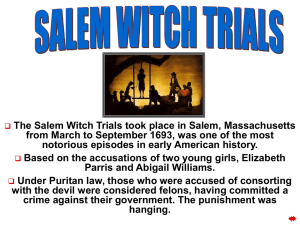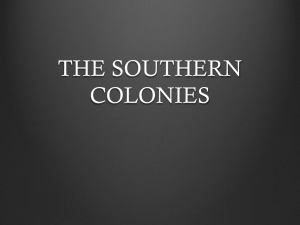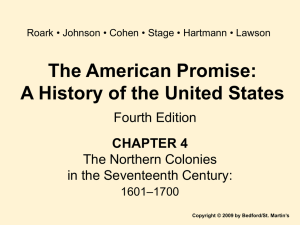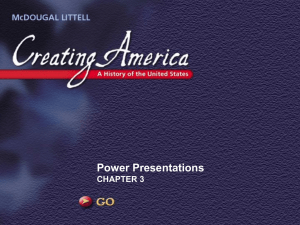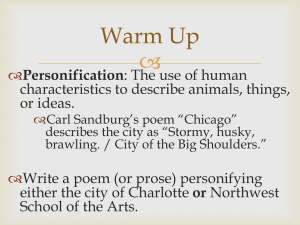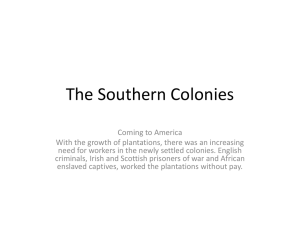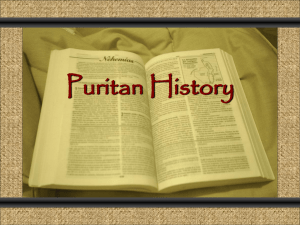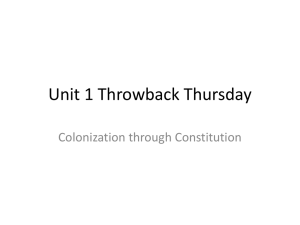lecture3
advertisement
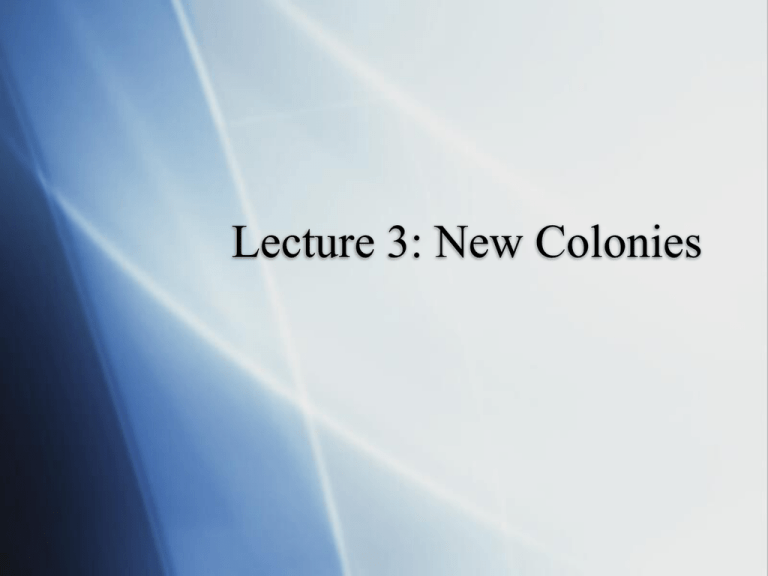
Lecture 3: New Colonies Puritan Refugees: Connecticut and Rhode Island The Puritan migration to New England was very marked in its effects in the two decades from 1620 to 1640, after which it declined sharply for a while. The term Great Migration usually refers to the migration in this period of English settlers, primarily Puritans to Massachusetts and the warm islands of the West Indies, especially the sugar rich island of Barbados, 1630-40. They came in family groups, rather than as isolated individuals and were motivated chiefly by a quest for freedom to practice their Puritan religion. Famous Puritans: Thomas Hooker Roger Williams Anne Hutchinson Propriety Colonies: Maryland and Pennsylvania Maryland named after the King of England's wife Henrietta Maria, who was a catholic. Many of the people living in Maryland practiced the catholic faith making it unique in the colonies as most were protestants. Its economy was based on tobacco. Pennsylvania Given land by King Charles the II as payment, William Penn was giving a large pact of land west of the Delaware River. Penn and his family belonged to the Quaker sect, a religious group that favored religious toleration and pacifism. The Quakers had been prosecuted in England for their unwillingness to pay taxes to support the English military or the church. This led to Penn opening up his colony for anyone who was being persecuted. Pennsylvania attracted many farmers from Germany and England. Philadelphia comes from the Greek meaning “city of brotherly love.” The Carolinas Named after King Charles II The economy was based on tobacco plantations. By 1675 North Carolina had a population of over 5,000. Settlers from the overcrowded islands of Barbados founded another colony. The settlers brought over many slaves who made up almost half of the colony’s population. New York During the early 17th century the independent Netherlands established a fur trading colony along the Hudson river-at the tip of Manhattan Islandcalled New Amsterdam. The Dutch West-India Company’s alliance with the Iroquois soon enabled it to dominate the fur trade throughout the Great Lakes. Societies in Conflict Relations between the colonists and native Americans were at first peaceful, but with new diseases and the need for expansion, violence once again reared its head. Major Conflict include: King Philips War 1675 Nathanial Bacon’s Rebellion 1676 Salem Witch Trials 1692 King William’s War 1689 King Philips War King Philip's War, sometimes called Metacom's War, Metacomet's War, or Metacom's Rebellion,[1] was an armed conflict between Native American inhabitants of present-day southern New England and English colonists and their Native American allies in 1675-1676. The war is named after the main leader of the Native American side, Metacomet, known to the English as "King Philip". Major Benjamin Church emerged as the Puritan hero of the war; it was his company of Puritan rangers and Native American allies that finally hunted down and killed King Philip on August 12, 1676. The war continued in northern New England (primarily on the Maine frontier) after King Philip was killed, until a treaty was signed at Casco Bay in April 1678. The war was the single greatest calamity to occur in seventeenth-century Puritan New England. In little over a year, nearly half of the region's towns were destroyed, its economy was all but ruined, and much of its population was killed, including one-tenth of all men available for military service.[5] Proportionately, it was one of the bloodiest and costliest wars in the history of North America. More than half of New England's ninety towns were assaulted by Native American warriors. King Philip's War was the beginning of the development of a greater American identity, for the trials and tribulations suffered by the colonists gave them a group identity separate and distinct from subjects of the English Crown. Bacons Rebellion Bacon's Rebellion was an uprising in 1676 in the Virginia Colony in North America, led by a 29year-old planter Nathaniel Bacon. About a thousand Virginians rose because they resented Virginia Governor William Berkeley's friendly policies towards the Native Americans. When Berkeley refused to retaliate for a series of Indian attacks on frontier settlements, others took matters into their own hands, attacking Indians, chasing Berkeley from Jamestown, Virginia, and torching the capitol. It was the first rebellion in the American colonies in which discontented frontiersmen took part; a similar uprising in Maryland occurred later that year. A protest against raids on the frontier; some historians also consider it a power play by Bacon against Berkeley, and his policies of favoring his own court. Their alliance disturbed the ruling class, who responded by hardening the racial caste of slavery. While the farmers did not succeed in their goal of driving Native Americans from Virginia, the rebellion did result in Berkeley being recalled to England. Salem Witch Scare Salem Witch Trials… In 1691 several young women in the Massachusetts port of Salem were accused of witchcraft. Throughout 1692 the community was in turmoil, with over 100 women and a few men accused of involvement in witchcraft. 20 individuals were convicted and executed before the new governor ordered a halt to the trials. Most commonly those accused of witchcraft were old women, unmarried or widowed, who were denounced by their neighbors out of fear and jealousy. The accused came from the more prosperous commercial parts of the town and were members of religious minorities, such as Anglicans and Quakers. Their accusers were largely from areas of the town that were suffering economically, and were mostly Puritans. King William’s War In the final decade of the 17th cent a lengthy struggle began b/w France and England for control of North America. The first part of the conflict, known in North America as King William’s War, began in 1689 when a combined force of English and Iroquois attacked Montreal. The French who were allied with the Algonquins also raided frontier settlements. The importance of this war is that it foreshadowed the imperial struggle of the 18th cent and led governments to increase their control over the American colonies in order to ensure a more coordinated defence. In 1701, the English took direct control over the proprietary colonies, ensuring that each colony had a royal governor. Emerging Patterns Impact of contact b/w natives and colonists. Natives struggle to adapt Equality disappearing b/w groups People came for economic and religious freedom Differences were emerging between urban and frontier society Check your understanding 1. What reasons did Anne Hutchinson and Roger Williams have for leaving Massachusetts and establishing a colony in Rhode Island? 2. Why were the colonies of Maryland and Pennsylvania founded? 3. What were the common factors in King Philips War, Bacons Rebellion, and other conflicts with Native Americans? 4. How did the Iroquois use their relations with the English? 5. What relationships are shown between the Native Americans and the English and French in King Williams War?
